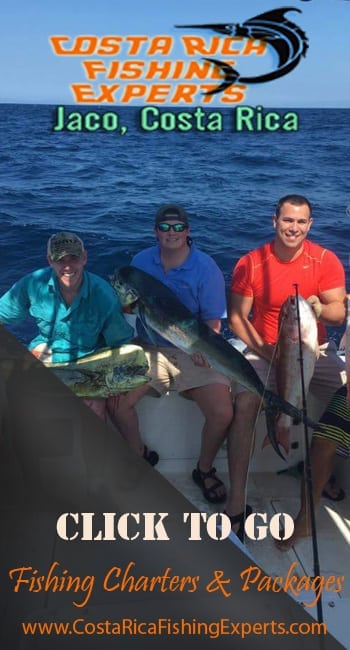Tamarindo Fishing Charters
You'll find something to love in Costa Rica
Sportfishing in Tamarindo Costa Rica
Sportfishing in Tamarindo, Costa Rica, is home to the world of sport fishing world-class recognition. The deep waters of the Pacific Ocean Lady have a large number of species that are sure to challenge you. Our selection of boats and captains are professionals Tamarindo Bay that has fished these waters for years for his unforgettable fishing experience. If you are a beginner or a seasoned professional, we can meet your needs. And, again, Our Team Costa Rica will do everything possible to find others to share the pot to make this experience accessible to all budgets.
What to expect: —– Fishing Costa Rica Experts Phone 506 8310 8393 info@costaricafishingexperts.com
The dry season from January to March
Full-Day Off Shore
This time of year can be the best Blue and Black Marlin fishing in the world. Boats depart 35 minutes south of the calm blue sea. It is not uncommon to get two a day Marlin. Also, Pez Vela, Dorado (Mahi Mahi), bigeye and yellowfin (up to 250 pounds) to be captured.
Half-day on the coast
Roosterfish abounds worldwide Great class along the beach as well as small game and fish Skipjacks, mackerel, Spanish mackerel, and Rainbow Runner. Near (ten minutes walk) reefs can produce some big fish like Wahoo, Snapper snapper, grouper, tuna, dorado, and maybe a sailboat.
Season: April to December
Full-Day Off Shore
It is the sailfish season not uncommon to see 30 yachts in a day, and Dorado and Tuna. Marlin (blue, black, and rays) can come in strong at all times.
Half-day on the coast
Local reefs, ten minutes from the beach, are filled with tuna, Dorado, Wahoo, and Rainbow Runner with always the possibility of a sailboat or a big bottom fish like grouper or amberjack. The fisherman can catch large sharks on the reef.
We recommend the full-day fishing charter draft law would be fishing.
A vacation destination perfects and well known as great Costa Rica fishing spots. Sea fishing trips in Tamarindo Beach Guanacaste Costa Rica. Tamarindo Beach is one of the most popular tourist destinations in Guanacaste, Costa Rica. This beach has all the amenities of a beach town in Costa Rica surf, sand, and sun, sun, sun. But it offers much more. It is ideal for honeymoons and weddings, couples and families, and wonderfully suited to eco-adventures.
Tamarindo offers class sport fishing, sailing, surfing, golf, ATV tours, turtle watching, diving, horseback riding, canopy tours, jungle tours, beauty salon, an art gallery, and craft shops, and first ceramics. A multicultural community in Tamarindo finds several bakeries, a vegetable market outdoors, and over 40 restaurants. If you like to eat vegetarian, “Tipico Costa Rica, Italian or sea, everything is there.
Playa Tamarindo, Playa Tamarindo or, as it is popularly known, is located on the northwest Pacific coast of Guanacaste province and offers a variety of services and easy access.
Tamarindo is physically located in a wide bay with white sand beaches and fantastic surf and is bordered by both seawater and estuarine lute National Park. Come Easy: Tamarindo has an airstrip with regular daily service: only one flight from San Jose to 45 minutes Sansa or Nature Air airlines. Liberia International Airport Daniel Oduber is less than an hour‘s drive away.
Even if it is a small beach community, Tamarindo offers a variety of services, including banks, grocery stores, pharmacies, emergency medical centers, Internet cafes, and many shops to explore. International cuisine is presented from a wide variety of excellent restaurants.
If you’ve ever been to Tamarindo, try one of our other fishing sites in Costa Rica Carrillo, Flamingo, and Conchal. Visit the local website for Fishing in Playas Cocos, Hermosa Beach, Ocotal, and Others https://papagayofishingcostarica.com
Jaco Beach Central Pacific Fishing, Los Suenos – https://bigfishcostarica.com/ Phone: tel:+506 8524 0071 Email – info@bigfishcostarica.com
[gravityform id=”1″ title=”false” description=”false”]
Sportfishing Costa Rica
Playa Tamarindo, Costa Rica is home to world-renowned sportfishing. We offer year-round offshore action with Sailfish, Marlin, Dorado, Tuna, Wahoo, while inshore we catch Roosterfish, Cubera Snapper, Amberjack, and more. Whether you are a novice or a seasoned pro, we can accommodate your needs.
Conservation minded our Captians, are highly experienced, extremely enthusiastic about fishing, and very friendly.
Quite simply put, Tamarindo, Costa Rica has Awesome Sportfishing!
We encourage our anglers to hook their own fish and invite them to be as hands-on as they want.
Our fully equipped boat and experienced crew will do what it takes to ensure your greatest chance for success.
Contact us now to plan for the fishing adventure of a life time!
Sportfishing on the Pacific Coast
Tamarindo SportfishingThe boat, Tantrum II, is a 26 foot Boca Grande custom sportfisher, powered by a Cummins turbo-diesel. She is set up for serious fishing with a tower, outriggers, depth-sounder and GPS. She is ideal for Fly fishing.
We provide top quality Shimano 20 lb. to 50 lb. stand-up tackle. Flyfisherman need to bring their own tackle.
We can comfortably fish four persons and Tantrum II has lots of shade and a head. We also provide bait, ice, soft drinks, water, beer, snacks. Lunch is provided on full-day charters. Safety equipment includes VHF radio, life jackets, cellular phone, anchor, flares, and fire extinguisher.
We recommend full-day charters when targeting billfish offshore. Offshore we troll, bait and switch, and live bait for Marlin, Sailfish, Tuna, Wahoo, and Dorado. Nearshore we troll, drift, and cast for Roosterfish, Snapper, Amberjack, and Grouper.
We release all Billfish but we’ll be glad to arrange for one of the fine local restaurants to prepare your table fish.
Captain Philip Leman and his crew have many years of experience in the Tamarindo waters, and will work their hardest to see that your trip is a success.
Costa Rica Sportfishing
While we have productive fishing year round, the following is a general outline of our yearly fishing conditions:
April – August
Very calm seas and the fish are typically found very close to Tamarindo. The fishing can be absolutely on fire this time of year for sails, as well as marlin, tuna, and dorado. This is an excellent time of the year for catching sailfish on a fly rod.
September and October:
Can be very rainy but the fishing can be good for a variety of species including the really big yellowfin tuna.
November – March:
We see our largest number marlin, along with good numbers of sails, large tuna, and dorado. It can be windy this time of year and we often have to run up to an hour to the south to get out of the wind but once there, the seas are calm and the fishing can be outstanding. If you really want a Marlin, this is the time to come.
Sail Fish
Description
Color dark blue on top, brown-blue laterally, silvery white underbelly; upper jaw elongated in form of spear; first dorsal greatly enlarged in the form of a sail, with many black spots, its front squared off, highest at its midpoint; pelvic fins very narrow, reaching almost to the anus; body covered with embedded scales, blunt at end; lateral line curved above pectoral, then straight to base of tail.
The most common fishing methods are trolling. The three categories are artificial lures, live baits such as school size Dolphin or Bonita, and rigged natural baits like Mullet, Mackerel, Bonita or pelagic baitfish.
Black Marlin
Description
Color dark blue to black on back, vertical bars occasionally present, may not be obvious after death, belly silvery white, first dorsal fin low and rounded, less that 1/2 of body depth, second dorsal fin begins in front of second anal fin, pectoral fin is rigid in adults, more flexible in juveniles but will not lay flat against body without the joints breaking (only Marlin with this characteristic), pelvic fin is short.
Blue Marlin
Description
Cobalt blue on top shading to silvery white on bottom, upper jaw elongated in the form of a spear, dorsal fin pointed at front end, pectoral fin and anal fin pointed, lateral line reticulated (interwoven like a net, difficult to see in large specimens), no dark spots on dorsal fin, body covered with embedded scales ending in one or two sharp points.
Blues are voracious and not very selective eaters. They will consume almost any baitfish presented to them, but their preferences are mackerel, squid, dolphin, and tuna.
Darodo
Description
Bright greenish blue above, yellow on sides, with capability of flashing purple, chartreuse, and a wide range of other colors; body tapers sharply from head to tail; irregular blue or golden blotches scattered over sides; anterior profile of head on adult males is nearly vertical; head of females more sloping; the single dark dorsal fin extends from just behind the head to the tail; anal fin margin concave and extending from anus to tail.
Yellowfin Tuna
Description
The body of the yellowfin tuna tapers at both ends (cigar-shaped), and the head is conical. The color is dark brownish blue to dark yellow on the back becoming gray or whitish below. Identifying tunas can be difficult, especially when yellowfin and bigeye tuna are involved. In most cases, the length of the pectoral fins can distinguish each species.
The yellowfin has pectoral fins which do not extend past the anal fin; while in bigeye, the pectoral fins extend well past the anal fin. Liver characteristics can positively identify tuna which cannot be distinguished by external features. The surface of a yellowfin’s liver is smooth while the organ of the bigeye is striated, containing many with small blood vessels along the trailing edge.
Rooster Fish
Description
Roosterfish or Pez Gallo are unique to the tropical Pacific. These fish are found in-shore near the sandy beaches. They are the predators of the surf. There are two ways to fish from roosters from a boat, those being by trolling live bait, such as horse-eyed jacks, blue runners, bonito, ladyfish, mullet, among other baits, or by casting lures towards the shoreline. Both ways are fun and can be done simultaneously.
It is important to remember to troll baits a fair ways back for larger fish, as they can be somewhat boat-shy. Circle hooks should be used when live-baiting. Usually while slow-trolling a live-bait, at least one angler will want to cast top-water lures such as “Klassic Poppers” and “Rangers.” Cast them right up onto the beach if possible and retrieve at a medium to fast pace towards the boat. Smaller roosterfish will also hit diving minnow -type lures, “Krocodile Spoons” and even plastic swim baits on occasion but these strikes would usually be made by smaller fish and are infrequent.
Call us at
Partner - ads





